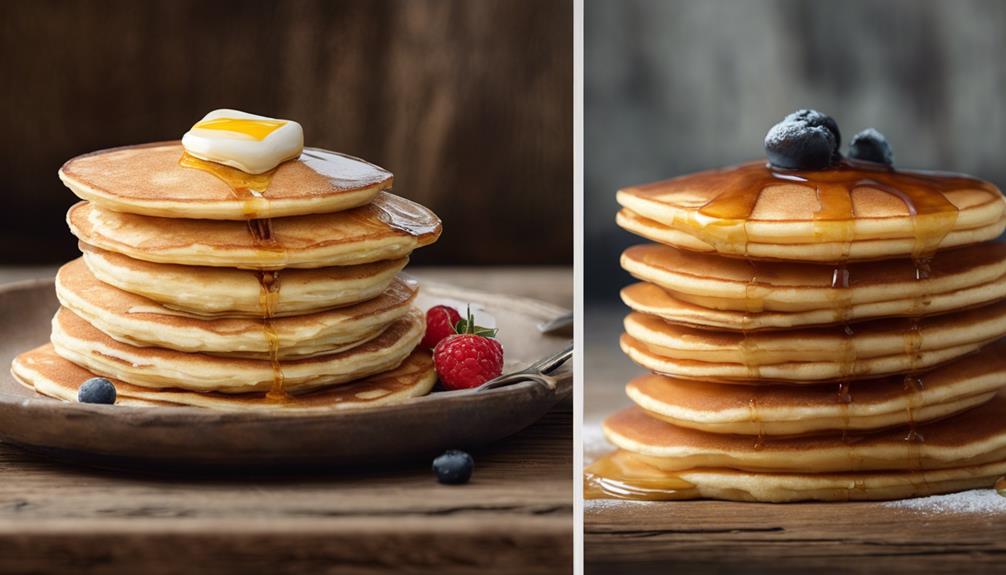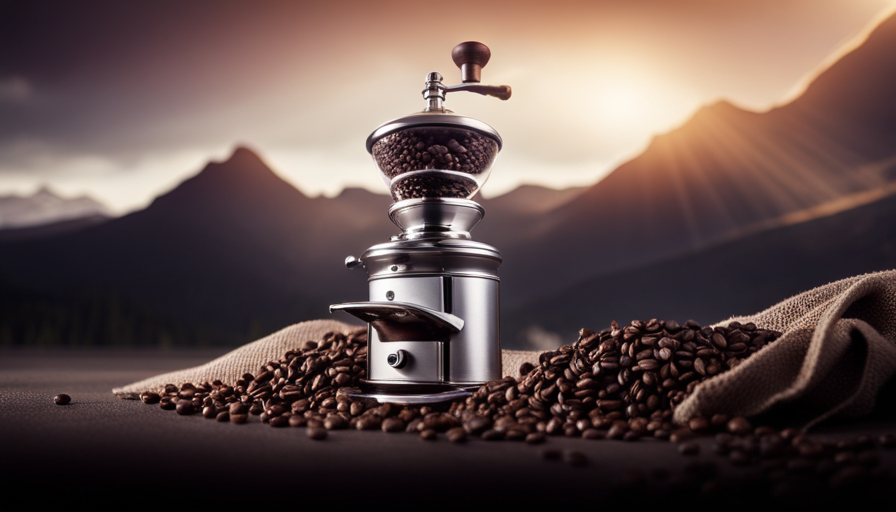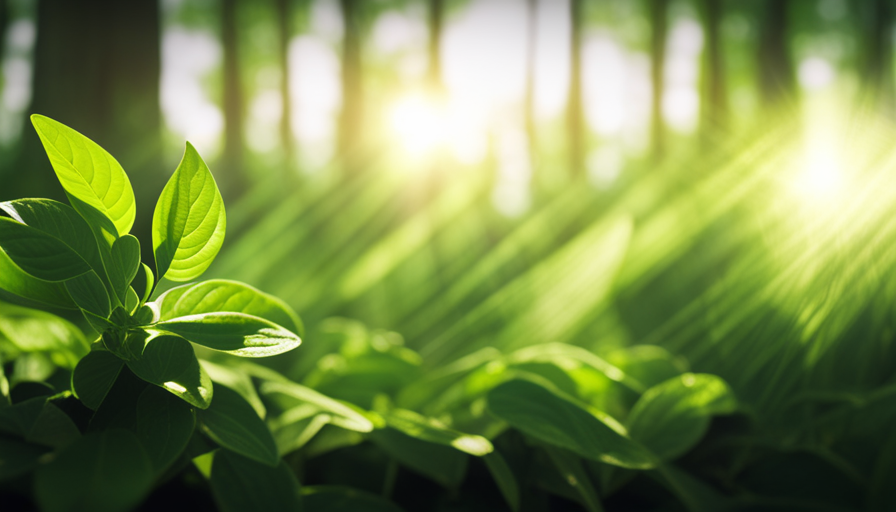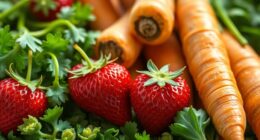Ensuring food safety and quality when serving raw oysters is crucial for food establishments. This involves adhering to essential practices such as strict purchasing controls to ensure shellfish meet standards, thorough receiving controls for timely inspections, rigorous cleaning procedures to maintain oyster quality, proper storage controls below 41°F, and vigilant serving controls to prevent contamination. It is essential to train staff on quality assessment techniques, communicate transparently about risks, and prioritize safe food handling practices. By carefully following these guidelines, food establishments can ensure customer satisfaction and safety.
Key Takeaways
- Adhere to strict shellfish procurement guidelines for quality assurance.
- Implement thorough shellfish inspection upon delivery.
- Store shellfish correctly to maintain freshness and quality.
- Follow proper cleaning procedures to ensure food safety.
- Serve shellfish with caution, prioritizing customer well-being.
Purchasing Controls
I always guarantee strict adherence to our standard purchase specifications when procuring shellfish to maintain quality and safety standards. Following food safety regulations is vital in our procurement process. We meticulously vet shellfish suppliers, ensuring they meet our quality requirements and adhere to regulatory standards. It's essential to source shellfish solely from reputable vendors who are licensed and uphold the highest standards of safety. By verifying that the shellfish is harvested legally from approved beds, we not only maintain quality but also comply with regulatory standards.
Moreover, traceability is non-negotiable. We confirm the traceability of all shellfish back to their sources. This practice facilitates quick recalls if ever necessary, ensuring swift action in case of any concerns regarding safety. Partnering with trustworthy suppliers who share our commitment to quality and safety allows us to uphold these stringent purchasing controls effectively.
Receiving Controls
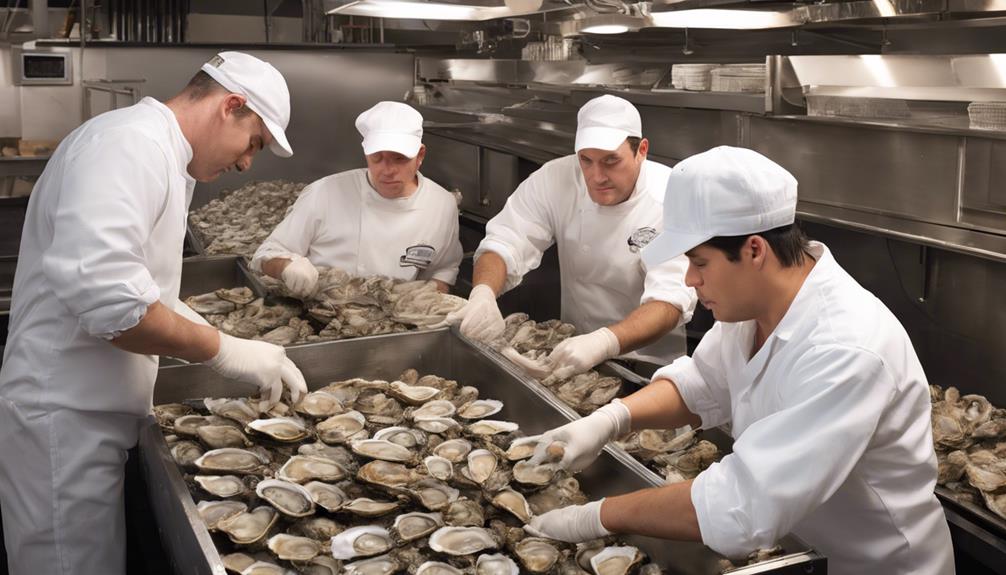
When it comes to receiving controls for raw oysters, temperature monitoring and storage guidelines are essential. Proper temperature checks upon delivery guarantee that the oysters are fresh and safe for consumption.
Adhering to storage guidelines helps maintain the quality and viability of the shellfish.
Temperature Monitoring
Upon receiving shellfish deliveries, vigilantly monitor temperatures to guarantee freshness and quality standards are maintained.
- Establish a delivery schedule: Ensure timely inspection to uphold freshness.
- Train receiving clerks: Educate on proper examination techniques for quality assessment.
- Accept only live and fresh shellfish: Maintain safety and quality standards by rejecting anything less.
- Reject unsafe temperatures: Discard shellfish exposed to improper conditions during transportation to prevent risks to food safety and quality.
Monitoring temperatures diligently is vital to make sure that the shellfish being received are safe for consumption and meet the necessary quality standards. It's essential to prioritize this aspect to maintain the integrity of the products being served to customers.
Storage Guidelines
To guarantee peak freshness and safety standards for shellfish, implement appropriate storage guidelines following receipt. Develop a delivery schedule with vendors to make sure timely inspections of shellfish deliveries.
Train receiving staff to meticulously inspect and accept only live and fresh shellfish, rejecting any that show signs of unsafe transportation conditions. When evaluating shellfish, look for shiny shells and check for a live response upon tapping to confirm freshness.
After proper inspection, maintain the quality and safety of shellfish by storing them under the correct conditions. Adhering to strict storage guidelines is essential for food establishments serving raw oysters to preserve the integrity of the product and uphold consumer satisfaction.
Cleaning Procedures
Regularly scrubbing raw oysters under cold running water is crucial to effectively remove dirt and grit before serving. This guarantees that the oysters are clean and safe for consumption in food establishments. Cleaning procedures play an essential role in maintaining the quality of raw oysters.
Here are some necessary steps to follow:
- Scrub: Gently scrub the oyster shells under cold running water to eliminate any dirt or debris that may be present on the surface.
- Soaking: Consider soaking the oysters in a mixture of cold water, salt, and cornmeal. This can help get rid of any sand residues that might be trapped in the shells.
- Rinse: Thoroughly rinse the oysters under cool running water to make sure that all sand and debris are completely removed.
- Avoid soaking scallops: To preserve the natural flavor and texture of scallops, it's best to avoid soaking them in water. Instead, handle scallops with care to maintain their quality.
Storage Controls
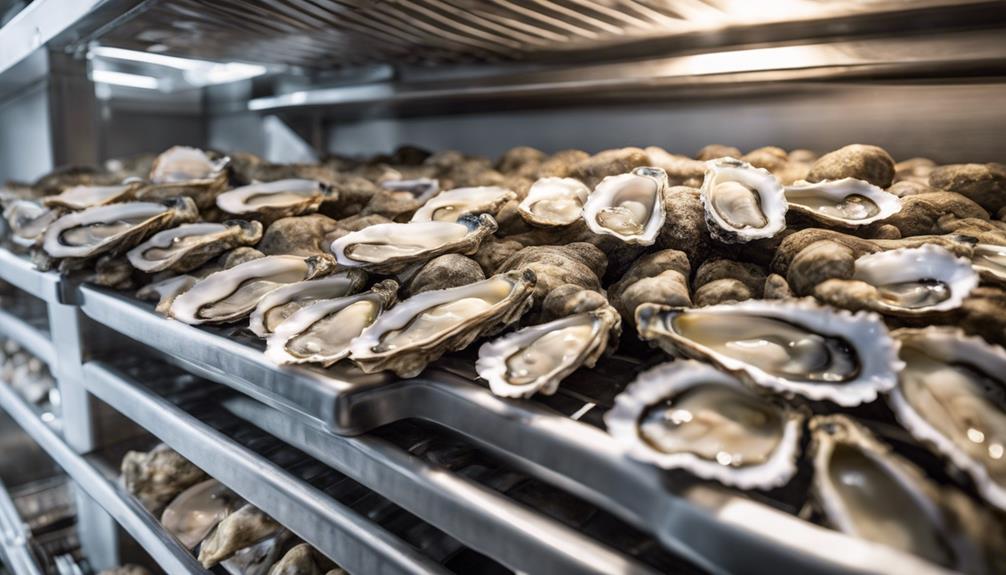
Ensuring proper storage controls for live shellfish is vital to maintain their freshness and prevent spoilage. When storing shellfish, it's essential to keep them at temperatures below 41°F to guarantee they stay fresh and safe for consumption. Additionally, storing shellfish in a well-ventilated area is pivotal to allowing proper air circulation, which helps prevent odors and maintain quality. Avoid using airtight containers as they can suffocate the shellfish or cause them to deteriorate quickly.
To create a moist environment during storage, cover live shellfish with ice or a damp cloth. Regularly inspect the shellfish for any signs of spoilage, such as off smells or a slimy texture. If any shellfish show these signs, it's important to discard them promptly to prevent any health risks. By following these storage controls, you can guarantee that the shellfish remain fresh, safe, and delicious for consumption.
| Storage Controls | Recommendations |
|---|---|
| Temperature | Below 41°F |
| Ventilation | Well-ventilated area |
| Containers | Avoid airtight containers |
| Inspection | Regularly inspect for spoilage |
Serving Controls
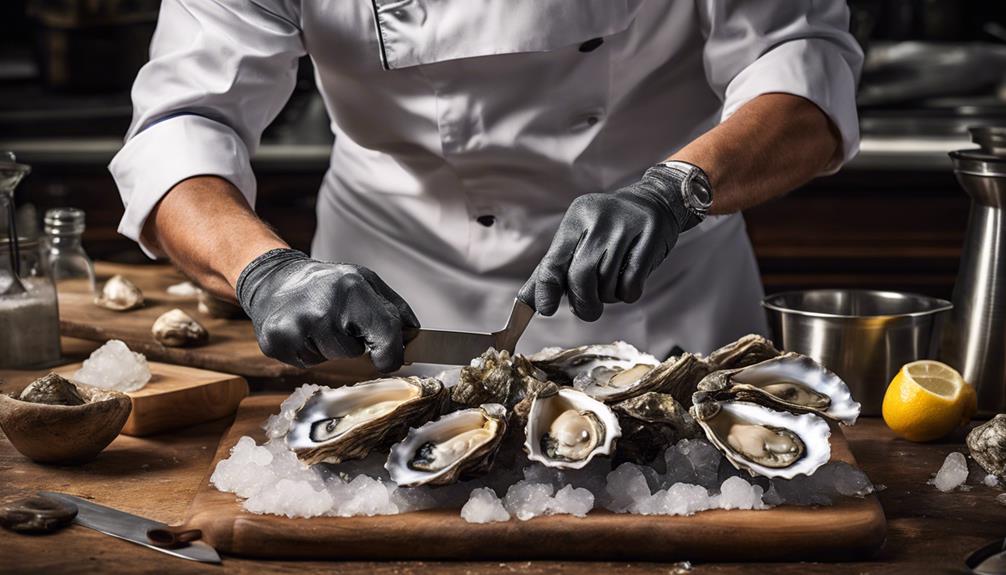
When serving raw oysters, prioritize implementing safe food handling practices to prevent contamination and foodborne illnesses. Ensuring the safety of raw oysters involves careful handling and proper procedures. Here are essential serving controls to uphold food safety standards:
- Maintain Cleanliness: Regularly sanitize all surfaces and utensils that come in contact with raw oysters to prevent cross-contamination.
- Monitor Temperatures: Keep raw oysters at appropriate temperatures to inhibit bacterial growth and maintain freshness.
- Check for Freshness: Inspect oysters before serving to confirm they're fresh and safe for consumption.
- Serve with Caution: Clearly communicate the risks associated with consuming raw oysters to customers, allowing them to make informed decisions about their food choices.
Staff Training and Communication
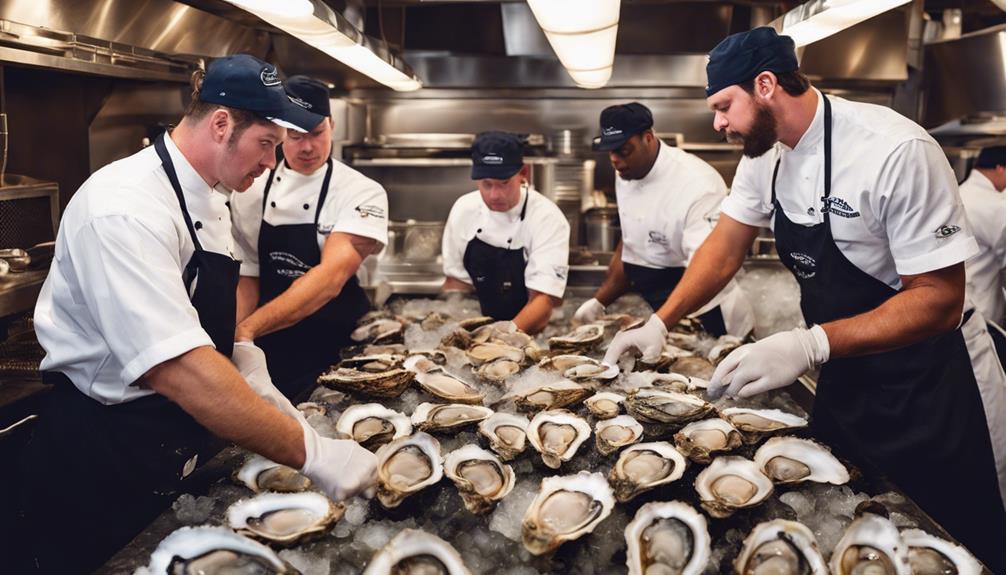
Staff training and communication are crucial components of ensuring the safe service of raw oysters. Clear guidelines and effective strategies help in educating staff about proper handling and serving protocols.
Clear Training Guidelines
To enhance staff competency in handling raw oysters, clear training guidelines must encompass essential safety practices from storage to serving.
- Proper storage techniques: Educate staff on maintaining precise temperature control to prevent bacterial growth in raw oysters.
- Cross-contamination prevention: Stress the importance of using separate utensils and designated work areas to avoid contaminating raw oysters with other foods.
- Consumer advisories: Emphasize the necessity of informing customers about the risks associated with consuming raw shellfish and the potential health implications.
- Regular staff training sessions: Conduct frequent meetings or refresher courses to reinforce safe food handling practices and address any new food safety regulations promptly.
Effective Communication Strategies
Incorporating effective communication strategies within staff training is vital for ensuring the safe handling and serving of raw oysters. Clear and transparent communication about food safety protocols, oyster handling, and contamination risks is essential. Staff training programs should emphasize the importance of regular updates on best practices to maintain a safe environment. Educating customers through menu advisories and providing information about the risks associated with consuming raw oysters promotes awareness and informed decision-making. By fostering open and transparent communication with customers, establishments can build trust and safeguard the well-being of their patrons. Below is a table summarizing key elements of effective communication strategies in staff training and customer education:
| Communication Strategies | Importance |
|---|---|
| Transparent communication | Ensures understanding of safety measures |
| Menu advisories | Educates customers about risks |
| Regular updates | Maintains a safe environment |
Frequently Asked Questions
What Should a Food Establishment Establishment That Serves Raw Oysters Have?
I need to have a HACCP plan, a license for selling raw shellfish, a consumer advisory on the menu, and a variance approved by the local authority. These measures are essential for safety and compliance.
How Should Raw Oysters Be Served?
When serving raw oysters, keep them chilled on ice for freshness. Shuck and serve immediately to maintain quality. Enhance with lemon, cocktail sauce, and mignonette. Use separate utensils to prevent cross-contamination. Display a consumer advisory on the menu.
What Is the Rule for Eating Raw Oysters?
When it comes to eating raw oysters, I always make sure to choose reputable sources to reduce the risk of foodborne illnesses. It's important to avoid oysters from contaminated areas and follow strict food safety guidelines.
What Can You Serve With Raw Oysters?
I love serving raw oysters with classic accompaniments like lemon wedges and cocktail sauce. They pair wonderfully with a glass of chilled champagne. The brininess of the oysters is perfectly complemented by the bubbly.
How Can Raw Oysters Be Safely Served in Food Establishments?
When serving raw oysters in food establishments, it’s crucial to ensure they’re sourced from reputable suppliers. Proper storage at the right temperature and regular monitoring for freshness are essential. Following strict food safety guidelines will result in perfect food servings for detox.
Conclusion
To sum up, implementing essential practices for handling raw oysters in food establishments is vital for ensuring the safety and quality of these delicacies. By following purchasing, receiving, cleaning, storage, and serving controls, as well as providing staff training and communication, businesses can reduce the risk of foodborne illnesses.
Remember, when it comes to serving raw oysters, it's better to be safe than shuck-sorry. Take the necessary precautions to protect your customers and reputation.


